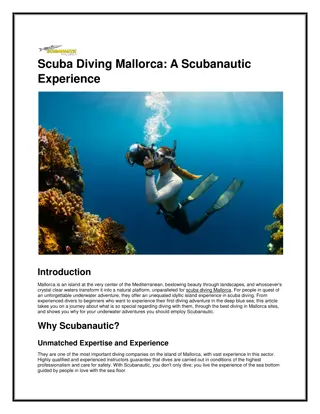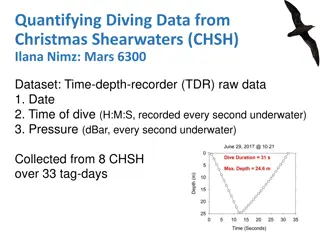Analysis of "Diving into the Wreck" by Adrienne Rich
Adrienne Rich's poem "Diving into the Wreck" reflects the societal turmoil of the early 1970s, intertwining themes of war, feminism, and justice. Rich's detached yet observational tone delves into human isolation and communal storytelling, using imagery and symbolism to convey the journey of self-discovery and connection. The poem explores the duality of solitude and connectivity, inviting readers to explore the depths of personal and shared experiences.
Download Presentation

Please find below an Image/Link to download the presentation.
The content on the website is provided AS IS for your information and personal use only. It may not be sold, licensed, or shared on other websites without obtaining consent from the author.If you encounter any issues during the download, it is possible that the publisher has removed the file from their server.
You are allowed to download the files provided on this website for personal or commercial use, subject to the condition that they are used lawfully. All files are the property of their respective owners.
The content on the website is provided AS IS for your information and personal use only. It may not be sold, licensed, or shared on other websites without obtaining consent from the author.
E N D
Presentation Transcript
Diving into the Wreck ADRIENNE RICH
Let's start out by setting the scene for "Diving into the Wreck." There was a lot going on in the U.S. when this poem was written (in the early 1970s). There was the Vietnam War, the struggle for women's rights, and the echoes of the Civil Rights Movement of the 60s. In many ways, Adrienne Rich was a major part of that world. She was (and is) a political poet. She was angry about the war, and she was also a strong feminist voice. Rich wasn't shy about connecting her work as a poet with her feelings about social justice. In fact, there's a story about this poem that we think says a lot about Rich, her views, and her career. When this poem appeared in 1973, it was part of a book with the same title: Diving into the Wreck. In 1974, that book won the National Book Award, a big deal for a poet. But Rich refused the award as an individual. Instead, she accepted it in the name of all unknown women writers. That was a big public gesture at a turbulent time. On the one hand, this story reminds us that Rich herself is important and influential. She's certainly won just about every poetry prize around. At the same time, she keeps a focus on the outside world, and on her responsibilities as a person and a writer.
Adrienne Rich uses an observational, detached tone in Diving into the Wreck to write a detailed poem that focuses on humanity; storytellers as observers, recorders, and explorers; and the isolation of life; as well as the shared community found through the experience of story, through the mythical inner journey of the writer who makes such things possible. From the beginning, the speaker is in a unique position of being alone and yet connected to others. I am having to do this/not like Cousteau with his/assiduous team/aboard the sun-flooded schooner/but here alone. Notice that the most stand-out image in this piece is of the sun-flooded schooner , which though it is contrasted to the speaker s own journey and not used to describe it, still sticks in the mind s image of the setting. Tonally, it s a statement with no overt emotion attached to it, as will persist throughout the rest of the poem except arguably in the very last paragraphs, near its climax. The feelings present in the beginning of the poem are less intense than they will become later, though at no point will the speaker ever reveal these feelings explicitly.
There is a ladder./The ladder is always there/hanging innocently/close to the side of the schooner./We know what it is for,/we who have used it. Here the speaker brings the reader into the poem for the first time by use of the word we , she is still alone, and yet not exactly alone, because she is following where others have gone before, a passage that has been experienced and documented by others, and which she now feels she must take herself. She is not talking of the physical ladder; here it represents a journey, or doorway. An invitation. Taking the invitation, prepared physically and mentally as much as it is possible to be, she goes down alone, for though connected to the others that have taken this journey before her, she must travel it by herself. There is no one/to tell me when the ocean/will begin.
It is a mythic story that she is now embarking on. Again, there is the reminder that she is alone, I have to learn alone/to turn my body without force/in the deep element Once under the water it is easy to forget/what I came for I came to explore the wreck./The words are purposes./The words are maps./I came to see the damage that was done/and the treasures that prevail. Story, maps, words to tell the story, to experience the story, she has to dive into the wreck. She cannot see from the boat above the surface of the waves what the wreck is, but must rely on her book of myths. Because she rejects those myths, or more precisely seeks to go beyond them, further than they allow, she comes into the water, taking her own journey to find the wreck and not the story of the wreck/the thing itself and not the myth a journey that is indeed another story not a question of power.
It is only in finding the wreck that she comes into deeper contact with those others who have taken the journey, as shown by the changing narration in the poem from I to we. Suddenly she is no longer alone. Interestingly, this is also where the strict reality and calm emotions that characterized the first section of the poem are supplanted by a more mythical, symbolic reality and emotionally-charged atmosphere. First the speaker is joined by others and then, in effect, becomes the wreck itself. For there is no understanding the wreck without becoming it, if only for a moment. The androgyny of the diver suggests not an original unity but the common bond of incompleteness, loss, and disrepair shared by all selves (Templeton). In shared loneliness, all those who have made the journey come together, and through the telling of the poem, the speaker gives the reader some of that gift, that understanding. Those on the journey have not lost themselves; this is in no way a journey of loss but of discovery, and healing. They are still explorers, still writers, still storytellers, the one who find our way/back to this scene/carrying a knife, a camera/a book of myths/in which/our names do not appear. In the end, through the use of a detached tone that never lands her too solidly on one side or the other, Adrienne Rich communicates detailed images of isolation and community that cause us to think deeply. The writer is ultimately a figure that bridges both sides of human existence.























